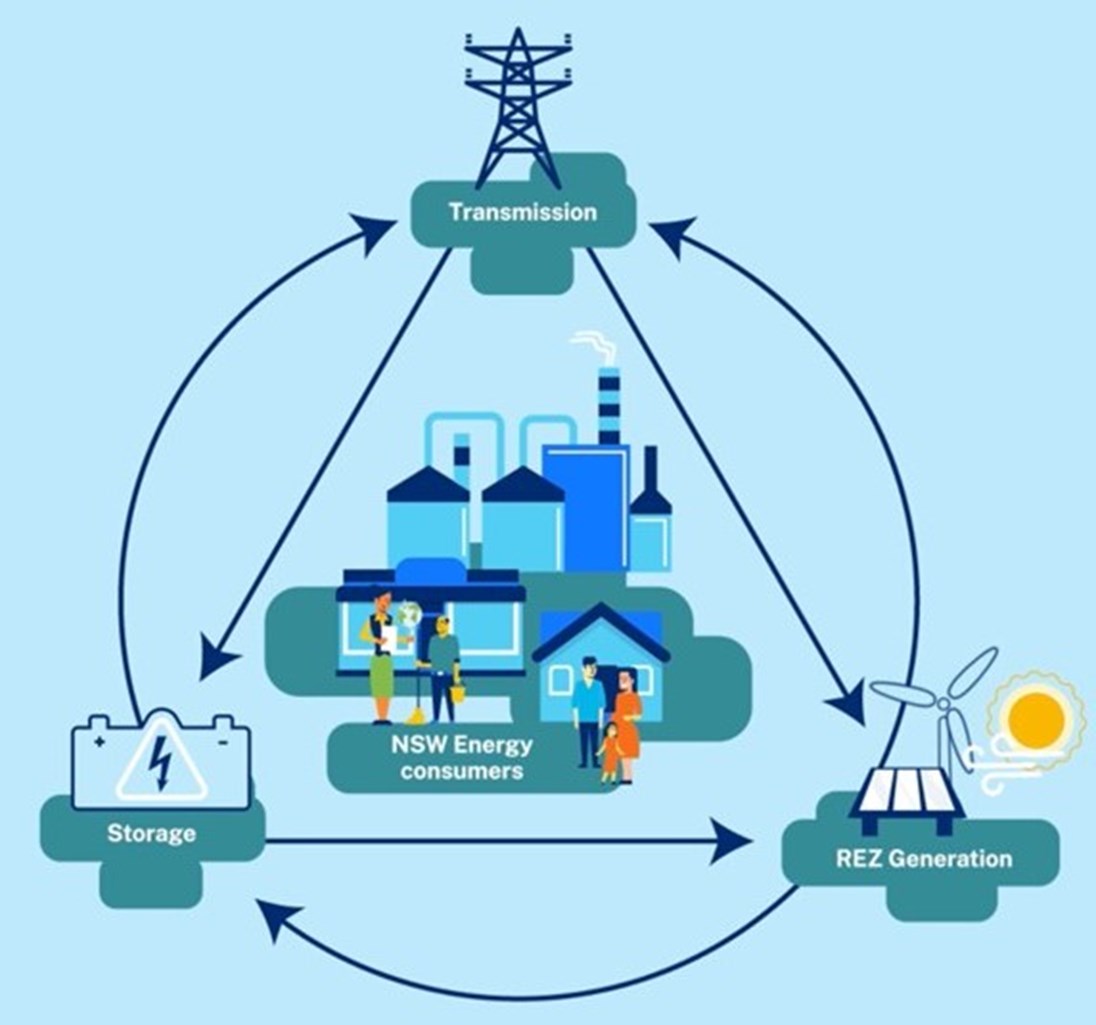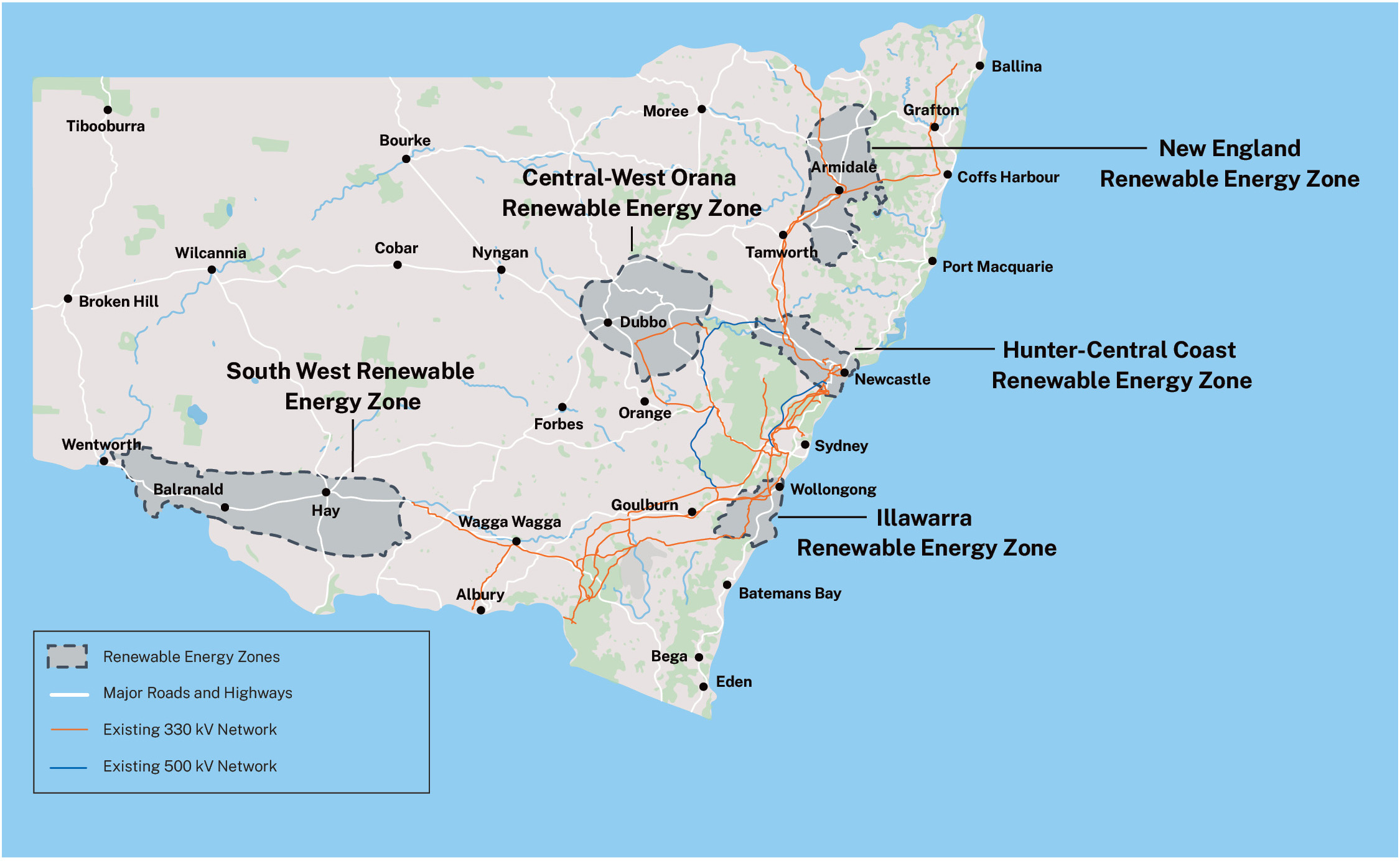Learn about the pivotal role of Renewable Energy Zones (REZ) in reshaping NSW’s energy landscape, and explore how Transgrid is at the forefront of this effort.
17 September 2023
In a concerted effort to foster a sustainable future, attention is increasingly being turned towards Renewable Energy Zones (REZ) - strategically located geographical areas identified for their abundant natural resources and their potential to efficiently harness wind and solar energies.
In this piece, we’ll explore how they act as cornerstones of the next chapter in our energy transition and delve into Transgrid's pivotal role in spearheading developments of energy superhighways in NSW, ushering in a new era of sustainable energy solutions.

What is a Renewable Energy Zone?
Renewable Energy Zones, or REZs, are often called ‘modern-day power stations’. They are the designated geographic locations with a high concentration of renewable energy resources, such as wind or solar.
They encapsulate large-scale energy generation, storage, and transmission facilities in one unified hub, thereby enhancing the stability and reliability of the power grid.
The advent of REZs is not only a leap towards environmental conservation but also a significant step towards a modern, integrated, and cost-effective energy system.
New South Wales Renewable Energy Zones
In NSW, REZs are part of the Electricity Infrastructure Roadmap to expand the power grid, achieve energy security, and accelerate green energy generation. The roadmap is expected to attract $32 billion in investment in regional developments, and generate 6,300 construction jobs and 2,800 ongoing jobs in 2030.
Before declaring an area as a REZ, the NSW Minister has to consider the impact on electricity costs for people in NSW and the infrastructure and investment objectives. They must also consult with the Australian Energy Market Operator (AEMO) and the Planning Minister, as well as make a draft declaration available to the public for 28 days.
REZ development may pose environmental impacts on animals, plants and habitats, while also affect local communities through changes in housing, skill training, and social infrastructure. As the NSW statutory authority appointed infrastructure planner, EnergyCo engages closely with communities, landholders, local councils, and many other stakeholder groups to understand key local issues to ensure that projects can provide long-term benefits to the communities that host them.
To date, these are the five areas for REZs that have been identified:
- Central-West Orana Renewable Energy Zone
- New England Renewable Energy Zone
- Hunter Central-Coast Renewable Energy Zone
- South West Renewable Energy Zone around Hay
- Illawarra Renewable Energy Zone
 Source: Renewable energy zone locations
Source: Renewable energy zone locations
Given the scale of the developments, REZs are expected to deliver lower wholesale electricity costs and increase competition. This helps to keep power bills as low as possible. They will also generate energy that powers industry, agriculture and manufacturing, helping keep Australian businesses thriving and competitive on the international market.
Why develop Renewable Energy Zones?
Australia is on a mission: to achieve net-zero emissions by 2050. This massive shift involves transitioning from fossil fuels to harnessing renewable energy resources. Australia has some of the best renewable resources in the world, but those renewables-rich areas are often located far from the people who need it. This means we need to connect these areas with the right infrastructure and transmission capacity to be able to send this clean energy to homes and businesses in NSW.
AEMO highlights that with the phasing out of coal-fired power plants by 2043, REZs are more vital than ever. Without urgent and sustained investment in new sources of electricity, and the transmission needed to connect it to consumers, there will be significant risks to reliability over the coming decade.
In the 2023 Electricity Statement of Opportunities report (ESSO) that AEMO released in September 2023, it also provides a 10-year reliability outlook that pints out reliability gaps and further reaffirms the need for urgently delivering planned investments in transmission, generation and storage projects.
Benefits of a Renewable Energy Zone
These designated areas are emerging as catalysts for sustainable growth and innovation. Here, we delve into some of the profound benefits these zones offer:
- Strategic planning and community engagement. REZ development goes beyond infrastructure; it incorporates active engagement with communities to foster collaboration and inclusivity. In NSW, strategic planning is grounded in up-to-date data and involves coordinated community consultation to facilitate the integrated development of these zones.
- Technical and regulatory design. Enhancing the transmission capacity is paramount to the success of REZs. In NSW, Transgrid is instrumental in developing network solutions that unlock the potential of renewable energy and ensure a seamless integration of new generation systems. We are also actively pursuing innovative ‘non-network solutions’ and emerging technologies to improve energy reliability and reduce costs for consumers such as investing in synchronous condensers and grid-forming inverters.
- Benefit sharing. Renewable Energy Zones aim to broadly distribute economic benefits, positively impacting communities through various benefit-sharing schemes. In NSW, actions are being taken to upgrade local infrastructure, including significant improvements to telecommunications and power distribution networks. Moreover, EnergyCo is also collaborating with the community and local stakeholders to identify how renewable electricity infrastructure projects can aid local industries, promote employment, and support communities.
- Economic opportunities for landholders. Renewable Energy Zones can potentially bring in substantial lease payments over time. For instance, the NSW roadmap projects that landholders hosting renewable energy generation projects could garner an estimated $1.5 billion in lease payments by 2042.
- Job creation: The development and operation of REZs create significant employment opportunities, fostering economic growth in the regions they are established. According to EnergyCo, REZs and the Electricity Infrastructure Roadmap are expected to deliver up to $32 billion in private sector investment and support around 6,300 construction and 2,800 ongoing jobs in 2030.
Transgrid's role in powering NSW's Renewable Energy Zones through transmission infrastructure
As we’ve already covered, a renewable energy zone or REZ is an area rich in renewable energy resources. But for us to use that energy, it has to get to us.
Existing transmission lines will do part of the work of transporting energy from REZs to consumers, but we need to build new ones to boost interconnection and unlock more power as we retire coal-fired power stations.
As we lead the way towards a clean energy future, we are working closely with communities, landowners, and customers to deliver network infrastructure. We also regularly undertake joint planning with AEMO and jurisdictional planning bodies from across the NEM, so that we can build a power system to serve our future generations.
Here are some highlights of our comprehensive approach:
-
Collaborative planning and development in Central-West Orana
As the State’s jurisdictional transmission planner, we will work closely with EnergyCo and key stakeholders in upgrading our transmission network to connect to the Central-West Orana REZ, which is poised to be Australia's first coordinated REZ.
-
Community engagement and environmental responsibility
As we progress projects to enable the Central-West Orana REZ we are keenly focused on assessing the possible community and environmental impacts. Firm in our commitment to working respectfully and cooperatively with landowners and communities, we are initiating non-invasive preliminary activities including environmental and ecological surveys. We continue to work with key stakeholders to determine preferred options for transmission infrastructure.
-
Infrastructure advancements in the EnergyConnect corridor
The EnergyConnect project stands as a landmark in our collaborative journey, facilitating the assimilation of both new and established renewable energy sources into the state's grid. The significant initiative covers the expansive area of the South West REZ, which includes notable regions such as Hay and Balranald.
This vital infrastructure lays the foundation for an efficient energy exchange between NSW, South Australia, and Victoria, securing a reliable grid connection for both existing and future renewable energy generators.
-
Looking ahead: future projects and collaborations
While our efforts are presently centred on the Central-West Orana and EnergyConnect, we are prepping to extend our expertise to forthcoming REZs, particularly in promising regions like New England, Hunter-Central Coast, and Illawara. Our goal is to sustain collaborative momentum with the NSW government, EnergyCo and other key stakeholders, with a vision to further cultivate the renewable energy landscape in the state.
Conclusion
Renewable Energy Zones represent a critical shift in energy production and distribution, marrying large-scale generation initiatives such as solar and wind farms with the necessary transmission infrastructure to securely deliver affordable, reliable, clean energy as well as socioeconomic benefits to communities across NSW and ACT.
At Transgrid, we are leading the energy transition by accelerating the nation-critical transmission projects needed to deliver clean and reliable electricity and enable greater sharing of energy between NSW, ACT, Victoria, Queensland and South Australia.
To find out more, visit: transgrid.com.au/projects-innovation
